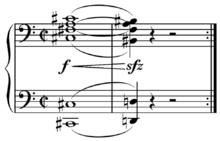Finlandia
| Finlandia | |
|---|---|
| Tone poem by Jean Sibelius | |
 The opening motif[1] | |
| Catalogue | Op. 26 |
| Composed | 1899 (r. 1900) |
| Duration | 8 minutes |
| Premiere | |
| Date | 2 July 1900 |
| Location | Helsinki |
| Conductor | Robert Kajanus |
| Performers | Helsinki Philharmonic Society |
Finlandia, Op. 26, is a tone poem by the Finnish composer Jean Sibelius. It was written in 1899 and revised in 1900. The piece was composed for the Press Celebrations of 1899, a covert protest against increasing censorship from the Russian Empire, and was the last of seven pieces performed as an accompaniment to a tableau depicting episodes from Finnish history.[2] The premiere was on 2 July 1900 in Helsinki with the Helsinki Philharmonic Society conducted by Robert Kajanus.[3] A typical performance takes between 7½ and 9 minutes.
In order to avoid Russian censorship, Finlandia had to be performed under alternative names at various musical concerts. Titles under which the piece masqueraded were numerous—famous examples include Happy Feelings at the awakening of Finnish Spring, and A Scandinavian Choral March.
Most of the piece is taken up with rousing and turbulent music, evoking the national struggle of the Finnish people. Towards the end, a calm comes over the orchestra, and the serenely melodic Finlandia Hymn is heard. Often incorrectly cited as a traditional folk melody, the Hymn section is of Sibelius's own creation.[4]
Although he initially composed it for orchestra, in 1900 Sibelius arranged the work for solo piano.[3][5]
Sibelius later reworked the Finlandia Hymn into a stand-alone piece. This hymn, with words written in 1941 by Veikko Antero Koskenniemi, is one of the most important national songs of Finland.
With different words, it is also sung as a Christian hymn (Be Still, My Soul, Hail, Festal Day, in Italian evangelical churches: Veglia al mattino[6]), and was the national anthem of the short-lived African state of Biafra (Land of the Rising Sun). In the spring of 1963, the Rice University student body voted to establish a school song (Rice is Our Home), using the music from the Finlandia Hymn. The song was played at the 1964 Rice Commencement, but otherwise never officially adopted.
Press Celebrations Music
Similarly to the Karelia Suite, the original Press Celebrations Music suite was never originally released under Sibelius' supervision, but after almost 99 years with the sheet music untouched, the suite was reconstructed and released on two different CDs, the first one by the Tampere Philharmonic Orchestra in 1998, conducted by Tuomas Ollila,[7] and the second by the Lahti Symphony Orchestra in 2000, conducted by Osmo Vänskä.[8][9] The last 2 movements of the suite were later reworked to become Finlandia[3]
The original movements are as follows.
- Preludium: Andante (ma non troppo)
- Tableau 1: The Song of Väinämöinen
- Tableau 2: The Finns are Baptized by Bishop Henry
- Tableau 3: Scene from Duke Johan's Court
- Tableau 4: The Finns in the Thirty Years' War
- Tableau 5: The Great Hostility
- Tableau 6: Finland Awakes
Recent use
- Finnish film director Renny Harlin featured Finlandia prominently in the film score for his 1990 film Die Hard 2: Die Harder.
- Finlandia is used for a love scene in Finders Keepers, Lovers Weepers! by Russ Meyer.
- Finnish symphonic power metal band Nightwish has used Finlandia as an intro to their live concerts, such as shows that are a part of their Imaginaerum World Tour.
- Before joining Nightwish, Troy Donockley had already played a version of Finlandia as guest musician for Mostly Autumn. This version can be found on the live album Storms over London Town.
- Joan Baez has performed "Finlandia" at her concerts since 2007 and also featured "Finlandia Hymn" on her 2005 live album Bowery Songs; a live performance of the song by Baez also appeared on the album Mitä vapaus on, a compilation of protest songs by various artists, released by Amnesty.
- On 8 December 2015, Sibelius' 150th birthday, Sibelius Academy of the University of the Arts Helsinki gathered over 1000 people on the Senate Square to sing Finlandia.[10]
- The Walking Dead season 7 episode 5 played Finlandia as Sasha and Maggie awoke in Hilltop in the middle of the night to a symphonic fanfare blasting from a parked car and the zombies are rolling in. The cars doors and windows are locked and Finlandia is played until the car is finally smashed by a truck by Maggie.
References
- ↑ White, John D. (1976). The Analysis of Music, p.26-27. ISBN 0-13-033233-X.
- ↑ See Grand Duchy of Finland and Russification of Finland for further historical context.
- 1 2 3 Sibelius – The Music
- ↑ Dubal, David. The Essential Canon of Classical Music, p. 466. New York: North Point Press, 2001.
- ↑ Sibelius, Jean. Finlandia Op.26 Nr.7 für Klavier zu zwei Händen, Wiesbaden: Breitkopf & Härtel, Nr 2415
- ↑ "Veglia al mattino – Chiesa Evangelica Valdese". www.chiesavaldese.org. Unione delle Chiese metodiste e valdesi. Retrieved 22 December 2015.
- ↑ Allmusic's information about of the recording by Tampere Philharmonic Orchestra
- ↑ Allmusic's information of the recording by Lahti Symphony Orchestra.
- ↑ Allmusic's general information about the suite.
- ↑ Nironen, Saija (8 December 2015). "Näin huikeasti Sibeliuksen Finlandia kajahti Helsingin Senaatintorilla – video" [This is how amazingly Sibelius' "Finlandia" was sung on Helsinki Senate Square – video] (in Finnish). Yle. Retrieved 8 December 2015.
External links
- Finlandia, Op.26: Scores at the International Music Score Library Project
- Full score of a number of Sibelius's tone poems, including this piece
- 2012 YouTube video recording of Finlandia Op. 26 by Jean Sibelius